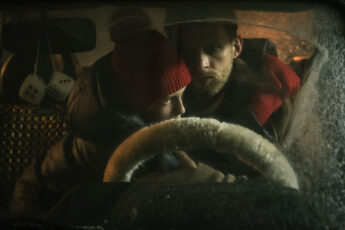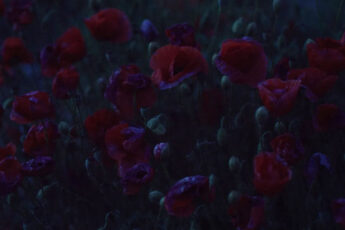Defense Against Chronocide
Sergei Loznitsa’s Babi Yar. Context (2021)
Vol. 116 (Summer 2021) by Antonis Lagarias
The term chronocide – the act of killing time -, when employed by Sergei Loznitsa to describe a threat he wishes to avert, is best understood as the act of killing memory, or perhaps, history itself. His latest film Babi Yar. Context, which premiered at the 74th Cannes Festival, is one of many attempts by Loznitsa to prevent and counteract chronocide. It reconstructs the events that led to the extermination of Kyiv’s Jewish population in September 1941. Over two days, the entire Jewish population of the city – an estimated 33.771 people – were gunned down in the Babi Yar ravine near the city’s old cemeteries. Between 1941 and 1943 more than 100.000 people were executed in the ravine, in what may be the earliest mass extermination case of the Second War World. Loznitsa’s film was commissioned and financed by the newly-founded Babi Yar Holocaust Memorial Center (2016), whose mission is to present a “comprehensive study of the distant and recent past of this territory”.1
This mission seems to fit well with Loznita’s long-established research on cinema’s power to fight oblivion. Unlike his State Funeral (2019) or The Event (2015), both of which focus on singular events, Babi Yar. Context presents a lengthy chronological reconstruction, starting with the German invasion in 1941 and ending with the political decision to transform the ravine into an industrial water-dumping site in the 1950s. The film is assembled out of archival footage – including famous testimonies of the 1946 trials -, still photographs, and titles cards. Loznitsa’s impressive compilation of archival material took years of research in different public institutions and private collections and includes rare footage like the public execution of 12 SS-soldiers in Kyiv’s central square for “atrocities against the Soviet people”. The filmic structure is fractured. Black images intervene between the shots, attesting both to the inevitable failure of memory and to the need to fight to preserve even its darkest moments. However, as Loznitsa has stated on different occasions, his films are less driven by a fear of forgetting than by a need to understand how people react under certain circumstances, “when the true nature of a human is revealed”.2
Sticking to his familiar film technique, Loznitsa adds an original sound design over the images, thereby creating a hyperrealistic soundscape designed by his lifelong artistic companion, Vladimir Golovnitski, which counterbalances the temporal distance of the images and offers an immersive viewing experience. This sound design includes fictional sounds of plausible events that may have happened. A most noticeable use of such fiction can be found during what seems to be a body recognition sequence. The archival images show a Soviet expedition and their discovery of tenths of dead soldiers’ bodies frozen in the snow. The camera focuses on the bodies, including close-up shots on their faces and upper parts. A hand is searching them, possibly to locate their names and rank. Over this shot, Golovnitski adds a soft melodic humming that presumably comes from a lone soldier who has grown accustomed to his grim task. This fictional element adds an interpretation layer to the image. The horror of death is now coupled with the inevitable triviality born in those who are tasked to manage it.
As the title suggests, the film attempts to contextualize the massacre. However, it can neither argue for a chronological causality, nor offer any way of coming to grips with such an event. Instead, it highlights another unspoken issue that still haunts modern societies’ relation to the Second War World: the silent collaboration of local residents with the Nazi forces. The film’s compilation of different archival sources includes conflicting war narratives. Official German propaganda is followed by amateur images of everyday life in occupied Kyiv, Soviet archives and images of war journalism. The director’s own thoughts on the events eventually emerge through the contrasting of these different perspectives. The Red Army retaking Kyiv seems like a reflected image of the German invasion, visually suggested by the constant replacement of Stalin’s portraits by those of Hitler, and vice versa. This kind of ideological replacement seems to entrap both the Ukrainian people and their cities, which are caught up in a flow of external forces and ideologies, passively and patiently obeying any act, however horrifying it may be.
Indeed, collaboration becomes the film’s omnipresent subtext. Loznitsa exposes Ukrainians saluting the arrival of Hitler-the-Liberator, the silent participation of Ukrainian-speaking soldiers in the extermination, the complicity of the public, the beating of Jews at the hands of their neighbors, and the complete lack of any protest at the horrific acts being committed, even as the murders became known. All of these acts reflect a failure of collective responsibility. After all, the Babi Yar ravine is in such proximity to the city, one could not but have heard or at least heard about the screams and gunfire. A fitting image for this ignorance we do not possess (and that may never have existed) would be a scene where the city residents intentionally turn deaf to these sounds, shutting their doors and windows, and then their mouths and minds. An actual image that we do possess is the crowd’s thrill and raw excitement during the public hanging of 12 SS-soldiers after the trials of 1946, which invites the contemporary viewer to question both the absence of resistance against the Third Reich, and the perversion of such enthusiastic, medieval-like retribution. Of course, this behavior of a frightened and lost people is not unique either to Ukraine, nor even to the Second World War context. It brings to mind the lines Manolis Anagnostakis, a Greek leftwing poet, opens with when describing the crowd’s reaction after the fall of the seven-year military regime (Junta) in Athens 1974: I am scared / of these people who for seven years / were pretending not to understand / and a fine morning – must have been mi-July – / went out to public squares, with their little flags, screaming / “Give the Junta to the People”.3 This emotional twist, from fear and passivity to retribution and then oblivion, is perhaps the essence of Babi Yar’s “context”, which surpasses a mere chronological narration of events, and arguably justifies the film’s otherwise questionable use of the public hanging’s spectacularly violent images.
It is not the first time that artworks have raised the question of Babi Yar’s remembrance. Jeff Kanew directed a feature film about the massacre in 2003, and Shostakovich’s Symphonie 13 opens with Yevgeny Yevtushenko’s line “There are no monuments over Babi Yar” (“Nad Babim Yarom pamyatnikov nyet“) from his 1961 poem. As always, Loznitsa’s ultimate goal is not simply to remember, but to steer the past so that a conversation about the future can finally commence. If in State Funeral, the viewer is exposed to an uncomfortable frenetic movement of a crowd adoring their dead leader, Babi Yar. Context adds to our understanding of how the unthinkable may be allowed to happen. It seems that both ideological fanatism and silent collaboration are unresolved issues that post-soviet Ukraine – and the contemporary nation state more generally – is still reluctant to discuss. At the same time, they mark some of the darkest findings of Loznitsa’s ongoing exploration of collective behavior.
References
- 1.Mission statement of the Babyn Yar Holocaust Memorial Center. https://babynyar.org/en/about [Accessed on August 4th 2021].
- 2.Quoted from the Babi Yar. Context Press Kit, published by Atoms&Void in May 2021.
- 3.Reprinted in: Gris, Ilias. To melani fonazei – h 17h Noembriou1973 sti logotechnia. Metaixmio, 2003. Translation by author.




Leave a Comment